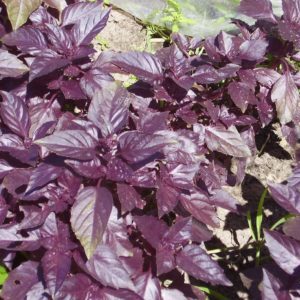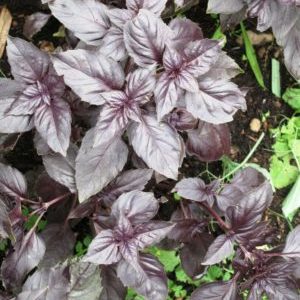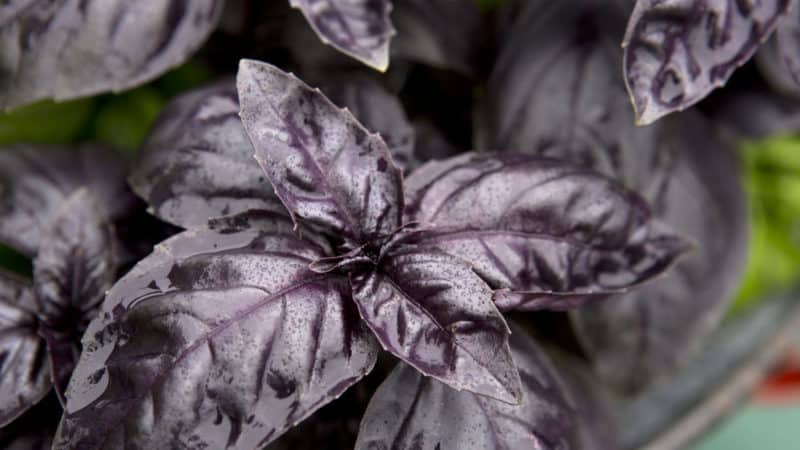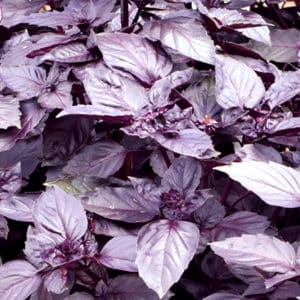Characteristics and description of the Opal basil variety and reviews of those who grew it
Basil Opal is unusual and attractive. It is grown in open ground in the garden, in containers or pots on the windowsill. It has an intense aroma and its pink flowers coupled with purple leaves add to the beauty of the plant. It is easy to care for. In addition to cooking, it is used in other areas.
Basil variety Opal
All varieties of basil are different from each other. They have different leaf colors, bush heights, flowers, aroma and taste. Depending on the variety, the plant requires certain care.
History of origin and distribution
The vegetable basil variety Opal was developed by American scientists John Skarchuk and Joseph Lent at the University of Connecticut in the 1950s of the 20th century.
Other names for the variety: Purple, Dark Opal, purple basil. It is widespread in the Caucasus, Central and Asia Minor. In 1962, Opal received the All-American Award.
Included in the state register of the Russian Federation in 2015 for cultivation on private farms.
Differences from other varieties
The culture is annual. The height of the bush ranges from 40 to 60 cm. The plant is branched, has many large ovoid leaves, dark purple in color with a purple tint. The flowers are bright crimson.
The variety is mid-season - 55-60 days pass from the first shoots to maturity. The yield of greens is 1.1-1.2 kg per 1 sq. m.
Purple basil is grown not only in open ground, but also on the windowsill.Thanks to the unusual color of the leaves and beautiful flowers, it decorates the room and decorates flower beds in the garden.
Characteristics and description
Opal is different from other varieties of vegetable basil. It is more spicy and fragrant. Its peppery aroma is pronounced and persistent. The variety is recommended for use in fresh and dried form as a flavoring additive in home cooking and canning.
Features of the chemical composition
Opal is a purple variety and contains essential oils and ascorbic acid. In addition, the plant contains the following beneficial substances:
- B vitamins: thiamine, folic acid, riboflavin, pyridoxine;
- beta-carotene, vitamin A;
- vitamin K;
- rutin, which improves blood quality and vascular condition;
- flavonoids that prevent aging and help the body absorb vitamins;
- essential oils that have a beneficial effect on the skin and blood vessels.
In the spring, the composition of Opal basil is dominated by essential oils, and at the time of flowering - ascorbic acid.
Durability
In general, the variety is resistant to diseases. Pests are repelled by its pungent smell. Only occasionally it is attacked by spider mites and aphids.
To prevent the plant from getting fungal diseases, it is important to avoid excessive watering. It is necessary to alkalize the soil in a timely manner, but it is better to plant it in a well-ventilated place and regularly loosen the soil.
Taste and aroma qualities
Opal basil gives off a distinct peppery aroma with hints of cloves. The taste of the plant is very pleasant, islandy.
Interesting! Essential oils from purple basil leaves are even used in perfumery.
Application area
In cooking, the stems and leaves of the plant are used as a spice. They are consumed both fresh and dried.Opal is added to vinegar, sauces and aromatic oils, and tea is brewed.
Basil is even used for medicinal purposes to prevent diseases of the digestive system and strengthen the immune system. It warms the body, gently calms the nervous system and relieves muscle spasms.
Reference. Chewing basil leaves relieves nausea and flatulence.
Basil Opal as an antibacterial agent helps in the fight against acne and treats insect bites. To do this, the leaves are crushed and the pulp is diluted with water.
To decorate the interior, Opal basil is planted in pots and placed on the windowsill.
Advantages and disadvantages
Opal basil has the following benefits:
- beneficial properties not only of leaves, but also of plant stems;
- decoration for the interior of the house and garden;
- source of ascorbic acid and essential oils;
- repels insects with its pungent odor;
- Tomatoes grow faster next to this basil variety.
Among the disadvantages are the following:
- slow maturation;
- during flowering, the taste of the leaves becomes bitter;
- grows poorly in low-light, cool places;
- annual plant.
Growing technology
Like other crops, basil has a special cultivation technology.
Optimal conditions
Basil Opal is an undemanding plant. It is better to plant it on the sunny side. He loves warm earth. Before planting, loosen the soil well, add compost or humus, as well as peat. The optimal temperature for growing basil is not lower than +18°C.
Landing dates and rules
The Opal variety is mid-season. The harvest is harvested 55-60 days after seed germination. Already on days 7-10, the first shoots appear.
It is recommended to plant the plant in a partially sunny place.During germination, make sure that the soil always remains moist, but do not allow stagnation of water. The soil is allowed to dry, and as soon as it becomes dry, it is immediately watered. The plant will die from excessive moisture.
As basil grows, it requires a sunnier location. The plant is propagated by cuttings: the tops of plants that have grown up to 20 cm are cut off, planted in a deep plastic container, watered and covered with a lid or polyethylene. This simulates greenhouse conditions. After two weeks, the plant takes root and becomes 3-4 cm taller. Cuttings replace sowing with seeds. This way the basil grows faster.
Since Opal grows more slowly than other varieties of basil, pruning begins when it has grown a little in height and has its first three leaves. First, trim or pinch the top leaves to encourage the development of new side branches. The crops are often cut. This promotes plant growth and the formation of a lush bush.
Attention! If you are growing purple basil for decoration, do not eat the leaves while they are blooming - they become bitter during this period.
Further care
Opal blooms a little later than other varieties - in mid or late summer. Pinch off the flower stalks if you plan to use basil for culinary or medicinal purposes.
Water the basil sparingly as soon as the soil becomes a little dry. On average, in the absence of rain, water no more than twice a week. For irrigation, use settled water at room temperature.
As weeds appear in the open ground, they are removed and the soil is loosened, saturating it with oxygen.
The plant is fed at the initial stage of growth and during the flowering period.
Suitable fertilizers:
- “Nitrophoska” (2 tbsp.The drug is mixed in 10 liters of water and watered at the rate of 5 liters per 1 square meter. m);
- superphosphate (15 g per 1 sq. m);
- ammonium nitrate (about 20 g per 1 sq. m).
Possible problems, diseases, pests
Basil is affected by the following diseases:
- black leg (a fungal disease that causes the stem to turn black, the plant does not feed well, turns yellow and dies);
- fusarium (a fungal disease that poisons the bush with toxins that cause the plant to die);
- gray rot (a fungus in the form of spots that affects the plant from the bottom up; the disease starts from the leaves and leads to death).
Basil is rarely attacked by aphids.
To avoid the spread of blackleg throughout the area, the infected plant is dug up and burned. The place where it grew is disinfected with formalin or a solution of potassium permanganate. Fitosporin and Topaz have proven themselves well in treatment. Other chemicals do not have sufficient effect.
Spraying diseased basil with an infusion of onion peels helps against fusarium and gray rot. The husk is poured with boiling water at a ratio of 1:4 and infused in a dark and warm place. A day later, the infusion is ready. It is filtered before use.
In order to prevent gray rot, basil is planted annually in a new place. Before growing, its seeds are kept in a weak solution of potassium permanganate.
If the basil has been attacked by aphids, use karbofos (30 g per 5 liters of water) or Akarin (8 ml per 1 liter of water).
Read also:
When to collect and how to properly dry basil.
Plant compatibility: what to plant basil next to and why it is important.
How to properly freeze basil for the winter: a selection of the best methods.
Features of growing seeds and seedlings
Basil Opal is grown both by seeds and by seedlings.The cultivation technology is similar to other varieties of basil.
Plants planted from seeds grow longer. Seedlings produce a harvest faster and long before planting in the ground. Cultivation by seedlings begins at the end of March. Sowing depth - no more than 1 cm. Temperature at the time of germination of inputs - not lower than +25°C.
After 10 days, the first shoots appear. They are allowed to grow about 4 cm upward, after which the top is pinched.
In the ground, greenhouse and at home
With the seedling growing method, basil is first planted in a greenhouse, where it gets used to a different temperature and soil. At this stage, fertilizing will be needed (1 teaspoon of nitrogen, phosphorus and potassium fertilizers per 1 liter of water).
When the outside temperature stabilizes at +18°C and above, the plant is planted in open ground. At first, water frequently so that the basil takes root.
At home, Opal is grown from seeds. Fertilizers are not required if the land was originally purchased at a special garden store. All necessary microelements are usually added to such soil.
Read also:
Is it possible to plant basil before winter and how to do it?
Reviews from summer residents
Many gardeners prefer the purple variety of basil.
Natalya, Tolyatti: “I really love basil. I once read reviews about Dark Opal basil, looked at the photo and now purchased the seeds and planted them. It has a simply stunning aroma! If you follow the planting rules described on the packaging, the harvest would probably be great. I missed the moment of planting seedlings in early spring, so I planted the seeds right away on my site. There were 100 seeds in the package, only 10 of them hatched.Next time I will sow more and better seedlings. Among the advantages, I would like to emphasize its definitely bright smell and pleasant mild taste. Among the disadvantages, I note that basil grows worse in open ground.”
Olga, Izhevsk: “I like purple basil for its appearance. A strong aroma emanates from the leaves. It blooms for only one season. I first germinate the seeds in March or early April in pots. I usually put it on the window. In the spring I plant it in a greenhouse. This basil is decorative and honey-bearing. Wasps and bees flock to him. We eat it fresh or add it to main courses.”
Nina, Otradny: “I have been growing the Opal variety for several years now. At home I plant with seeds, and at the dacha with seedlings. I noticed a couple of things. Often, of all my bushes, only a small part is purple, the rest for some reason remain green. My friends have the same story. Seedlings take root well only in a greenhouse. The bushes grow lush. In open soil, my basil grows sparsely.”
Conclusion
Opal basil has both leaves and stems that are edible. They are consumed fresh, dried and canned. In cooking, they are well suited for sauces, side dishes and first courses, for flavoring vinegar and tea. Due to the large amount of ascorbic acid and essential oils, the plant is used in folk medicine in the treatment of gastrointestinal diseases.
Basil is unpretentious in care. The main thing is to maintain moderate watering and keep the plant in a warm place. The crop grows best in a greenhouse.